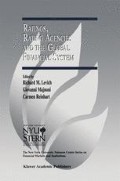Abstract
In capital market history, credit rating agencies were relatively late to appear, being less than a century old. John Moody founded the first rating agency in 1909, in the United States, which in comparison with other countries had a large private bond market and an investing class clamoring for better information. Extensive research by W.B. Hickman and others established that credit rating agencies were able to provide investors with good information on bond quality and the probability of default, but that the agencies’ record was not appreciably different from implicit ratings of public regulatory authorities and the bond market’s own ratings indicated by interest rate spreads. The paper concludes with a discussion of various rationales that have been given for the success of credit rating agencies as businesses in the United States and, increasingly, the world.
When the business of bond credit ratings by independent rating agencies began in the United States early in the twentieth century, bond markets—and capital markets generally—had already existed for at least three centuries. Moreover, for at least two centuries, these old capital markets were to an extent even ‘global.’ That in itself indicates that agency credit ratings are hardly an integral part of capital market history. It also raises several questions. W h y did credit rating agencies first appear when (1909) and where (the United States) they did in history? What has been the experience of capital market participants with agency credit ratings since they did appear? And what roles do agency ratings n ow play in those markets, which in recent decades have again become global, to an even greater extent than previously in history.
This essay explores the historical origins of agency bond ratings and the experience the capital markets have had with them in the twentieth century. T h e latter is pretty much a U.S. story until the 1970s, when the modem globalization of capital markets initiated a rerun of the U.S. story on a worldwide scale. Issues to be addressed include, in part 1, how and why the capital markets were able to function without agency bond ratings for so much their history, and why the agency rating business arose when it did. Part 2 examines the U.S. experience with agency ratings from their inception early in the century to the 1970s, with reference to the markets for both corporate and state and local governmental debt. Part 3 discusses the globalization of the agency bond rating business that has accompanied the globalization of capital markets since the 1970s, with some discussion of various rationales or explanations of the continuing importance of agency ratings in U.S. and global capital markets.
Access this chapter
Tax calculation will be finalised at checkout
Purchases are for personal use only
Preview
Unable to display preview. Download preview PDF.
References
Atkinson, Thomas R. (1967). Trends in Corporate Bond Quality. New York: National Bureau of Economic Research, distributed by Columbia University Press.
Bank for International Settlements (2000). Credit Ratings and Complementary Sources of Credit Quality Information. Basel Committee on Banking Supervision Working Papers, No. 3 (August).
Cantor, Richard, and Frank Packer (1994). “The Credit Rating Industry.” Federal Reserve Bank of New York Quarterly Review (Summer/Fall).
Chandler, Alfred D. (1956). Henry Varnum Poor: Business Editor, Analyst and Reformer. Cambridge: Harvard University Press.
Dickson, P.G.M. (1967). The Financial Revolution in England: A Study in the Development of Public Credit, 1688–1136. London: Macmillan.
Ferguson, Niall (1998). The House of Rothschild: Money’s Prophets, 1198–1848. New York: Viking.
Fridson, Martin (1999). “Why do Bond Rating Agencies Exist?” Merrill lynch Extra Credit (November/December).
Goldsmith, Raymond W. (1985). Comparative National Balance Sheets: A Study of Twenty Countries, 1688–1978. Chicago: University of Chicago Press.
Hempel, George H. (1971). The Postwar Quality of State and Local Debt. New York: National Bureau of Economic Research.
Hickman, W Braddock (1958). Corporate Bond Quality and Investor Experience. Princeton: Princeton University Press.
Hickman, W Braddock (1960). Statistical Measures of Corporate Bond Financing since 1900. Princeton: Princeton University Press.
Hickman, W Braddock (1953). The Volume of Corporate Bond Financing since 1900. Princeton: Princeton University Press.
Homer, Sidney, and Richard Sylla (1996). A History of Interest Rates. 3rd ed. revised. New Brunswick, NJ: Rutgers University Press.
Madison, James H. (1974). “The Evolution of Commercial Credit Reporting Agencies in Nineteenth-Century America.” Business History Review 48 (Summer).
Neal, Larry (1990). The Rise of Financial Capitalism: International Capital Markets in the Age of Reason. Cambridge: Cambridge University Press.
Norris, James D. (1978). R.G. Dun & Co., 1841–1900: The Development of Credit Reporting in the Nineteenth Century. (Westport, CT: Greenwood Press).
Olegario, Rowena (2000). “Credit Reporting Agencies in Nineteenth-Century America: What Can Developing Countries Learn from the U.S. Experience?” Paper presented at the World Bank Summer Research Workshop on Market Institutions, July 17–19.
Partnoy, Frank (1999). “The Siskel and Ebert of Financial Markets? Two Thumbs Down for the Credit Rating Agencies.” Washington University Law Quarterly 77 (October).
Sylla, Richard (1998). “U.S. Securities Markets and the Banking System, 1790–1840.” Federal Reserve Bank of St. Louis Review 80 (May/June), 83–98.
Sylla, Richard (1999). “Emerging Markets in History: The United States, Japan, and Argentina.” In R. Sato, et al., eds., Global Competition and Integration. Boston: Kluwer Academic Publishers, 427–46.
Author information
Authors and Affiliations
Editor information
Editors and Affiliations
Rights and permissions
Copyright information
© 2002 Springer Science+Business Media New York
About this chapter
Cite this chapter
Sylla, R. (2002). An Historical Primer on the Business of Credit Rating. In: Levich, R.M., Majnoni, G., Reinhart, C.M. (eds) Ratings, Rating Agencies and the Global Financial System. The New York University Salomon Center Series on Financial Markets and Institutions, vol 9. Springer, Boston, MA. https://doi.org/10.1007/978-1-4615-0999-8_2
Download citation
DOI: https://doi.org/10.1007/978-1-4615-0999-8_2
Publisher Name: Springer, Boston, MA
Print ISBN: 978-1-4613-5344-7
Online ISBN: 978-1-4615-0999-8
eBook Packages: Springer Book Archive

